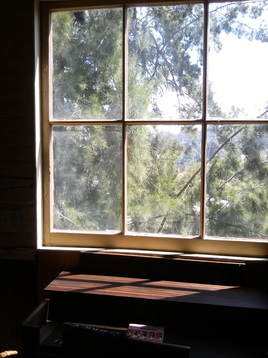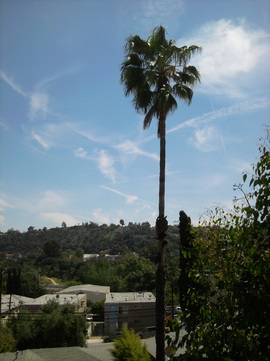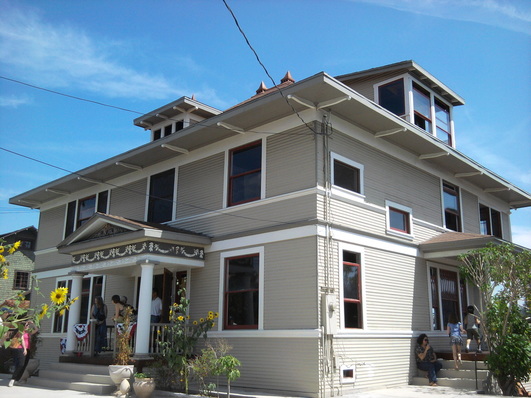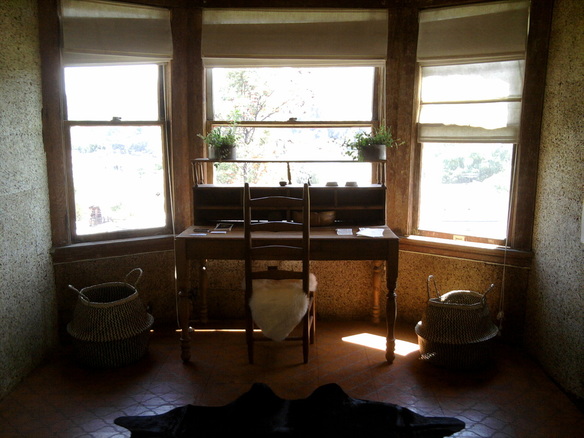Mount Angelus is one of Highland Park's many points-of-interest. Owned in the late 1800's by transplanted Boston socialite Cora Pond Pope, the steep, green acropolis was cut into gracefully meandering lanes and nooks per Pope's wishes. She christened said lanes and nooks after notable persons, including Abolitionists whom she admired.
Cora Pond Pope was a woman of vision, and she intended to crown Mount Angelus with a grand hotel. But the hotel was never built. Pope was a leader in the Women's Movement, and in the end she sold Mount Angelus to raise funds for the cause. It was her opinion that women needed rights more than Highland Park needed a grand hotel. And few would disagree.
The day after getting lost on Mount Angelus, I saw a notice for an open house on N. Avenue 66. The home in question was the Suffragists' House, built in 1887. People interested in LA and Highland Park history, and prospective buyers, were invited to drop in that afternoon for tours of the property. I was intrigued to read that one of the original owners of the house was none other than Cora Pond Pope.
Tours were self-guided, but there were plenty of pleasant people on hand to answer questions, members of the Highland Park Heritage Trust, and representatives of the realty firm handling the sale of the historic property. These guides were dressed in bygone fashions, bringing to life the old bohemian, arty days--as opposed to the new bohemian, arty days--of Highland Park.
A guide in the attic confirmed that the 1887 house is part of the Highland Park "Historic Preservation Overlay Zone"--or "HPOZ"--which means that the new owners won't be able to make any incredibly radical or damaging alterations to the property. That is certainly welcome news! I wish I had the means to buy the place. I would install myself in the ground floor writer's nook overlooking the arroyo, my niece in the art studio, my mother in a second-floor suite-of-her-own.
The guide in the attic spoke knowledgeably about Pope and the co-owner, Anna Howard Shaw, a tough and brilliant pioneer. Also a strong player in the National Suffragist Movement, Shaw, with Pope and others, was instrumental in organizing women's movement meetings in Highland Park, back when such meetings had to be held secretly. It was a secret society, because--although difficult to imagine it now--it was a dangerous undertaking, a brave endeavor in those days to advocate women's rights. The clandestine group met often at the 1887 house. If it can be proved that Pope and/or Shaw also used the house as a residence--documented proof of residency is elusive--the house will qualify for additional protections that will safeguard its status as an important local landmark.
The terrace is reached via semi-circular steps of the type used to gradually descend into a swimming pool. I wonder if the terrace area once was a pool. The vista is a knock-out, the arroyo stretching north and south, all smoothed stones and trickling water and new spring greenery. You could look at this view forever while you read, meditated, debated, created.
This view and this house make me hopeful. I hope that an artist or other creative type will buy the property, and invite their friends over, constantly, for music and laughter and artistic or literary collaboration. I hope that, perhaps, a creative family will buy it, and tumble up and down the stairs and in and out of the rooms with the riotous, hopeful, lively spirit of the visionaries and suffragists and bohemian types who preceded them.
And maybe the new occupants will find the proof that has eluded everyone so far, documentation that Pope or Shaw actually resided on the premises. Perhaps a scrap of journal will come to light in a back cupboard, or a scrap of photograph of some gathering with the proof inked across the back in an old-fashioned hand. It may be a long-shot. But this is a season, and a house, for hopefulness.
...............................................................................................................................................
Leslie Le Mon is a local author and designer who has lived in Highland Park since 1992. She is the author of "Downtown Los Angeles in Photographs 2014 - Broadway" and "Highland Park in Photographs 2015" as well as a number of other non-fiction and fiction titles. To contact her (especially with interesting historical tidbits about #LosAngeles, #HLP, and Disney) please email Leslie at [email protected] and/or follower her on Twitter @leslemonauthor.




 RSS Feed
RSS Feed
